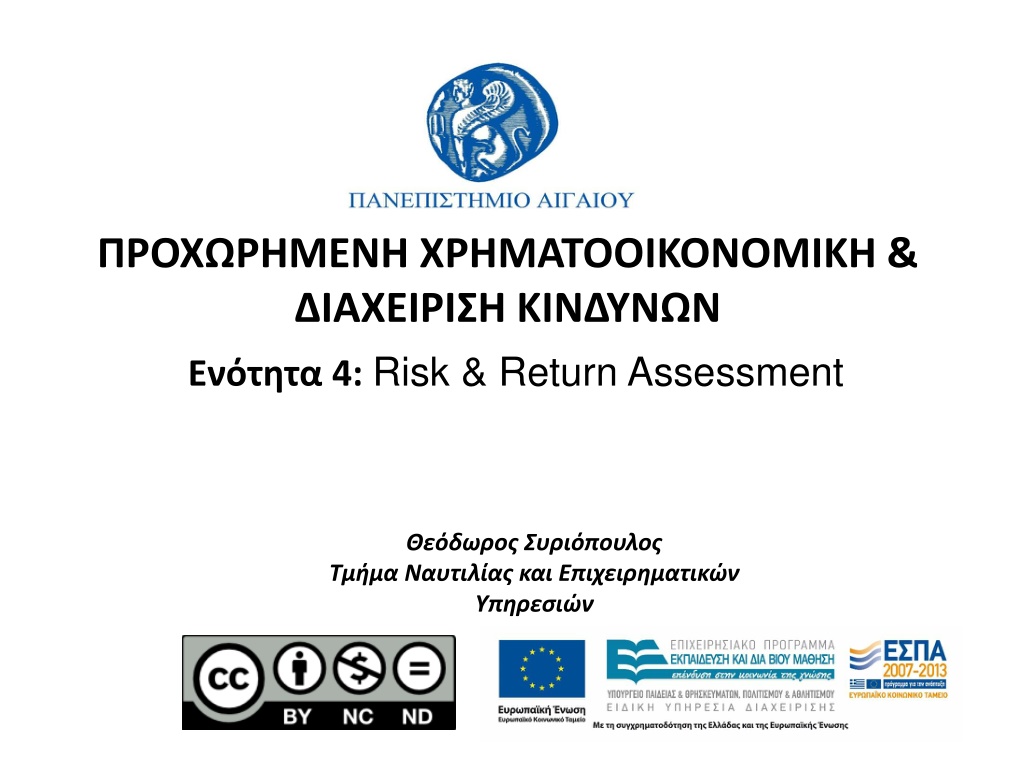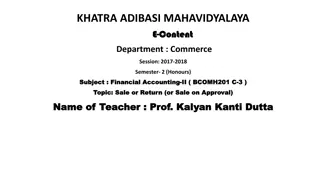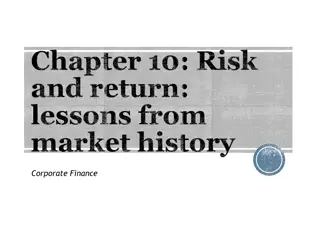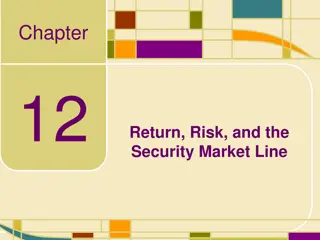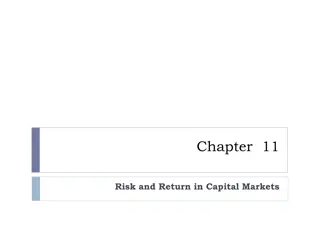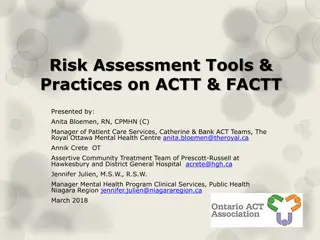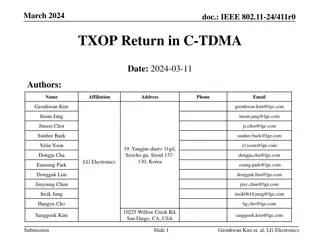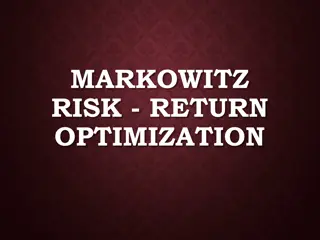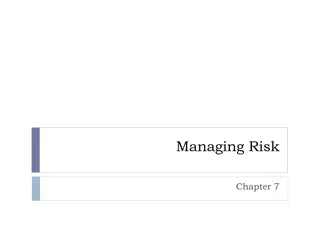Risk and Return Assessment in Financial Management
This comprehensive presentation explores the intricacies of risk and return assessment in the realm of financial management. Delve into understanding risk concepts, measuring risk and return, major risk categories, and the impact of risk aversion on investment decisions. Gain insights into the management of risk and uncertainty, as well as the importance of evaluating risk probabilities.
Download Presentation

Please find below an Image/Link to download the presentation.
The content on the website is provided AS IS for your information and personal use only. It may not be sold, licensed, or shared on other websites without obtaining consent from the author. Download presentation by click this link. If you encounter any issues during the download, it is possible that the publisher has removed the file from their server.
E N D
Presentation Transcript
& 4: Risk & Return Assessment
University of the Aegean School of Business Studies Shipping, Trade & Transport Dpt. MA Shipping, Trade & Transport e-course Advanced Corporate Finance ADVFIN THEODORE SYRIOPOULOS Professor of Finance Department of Shipping, Trade & Transport School of Business Studies UNIVERSITY OF THE AEGEAN 2A, Korai street, 82100 Chios, Greece, Tel.: 22710 35 861, 6944 911 787 e-mail: tsiriop@aegean.gr http://www.stt.aegean.gr/SyriopoulosEn.asp
Learning Objectives Understand the Concept of Risk in Finance Explain important types & measures of Risk Define the concept & measurement of Return Risk & Return in a Portfolio context Capital Asset Pricing Model (CAPM) 6
Risk & Uncertainty Decisions are taken in an environment of risk & uncertainty All of life is the management of risk, not its elimination ! 7
Risk aversion Rational (average) investor: risk-averse ! Of two investment alternatives, targeting equal returns . .. investors would prefer to choose the one bearing lower level of risk ! 8
Major categories of Risk Major Categories of RISK Market Risk STRATEGIC RISK Credit Risk BUSINESS RISK Liquidity Risk FINANCIAL RISK Operational Risk Legal Risk 10
Defining & Measuring Risk Risk probability (chance) that an unexpected outcome will occur a probability distribution is a listing of all possible outcomes with a probability assigned to each must sum to 1.0 (100%) 11
Probability Distributions Martin Products & U. S. Electric Rate of Return on Stock if this state occurs State of the Economy Probability of this state occurring Martin Products U.S. Electric Boom Normal Recession 0.2 0.5 0.3 1.0 110% 22% -60% 20% 16% 10% 12
Expected Rate of Return Rate of return expected to be realized from an investment during its life Mean value of the probability distribution of possible returns Weighted average of the outcomes, where the weights are the probabilities 13
Expected Rate of Return Martin Products Return if This State Occurs (ki) U. S. Electric Return if This State Occurs (ki) Probability of This State Occurring ( Pri) State of the Economy Product: (2) x (3) Product: (2) x (5) (1) (2) 0.2 0.5 0.3 1.0 (3) 110% 22% -60% = (4) 22% 11% -18% 15% (5) 20% 16% 10% = (6) 4% 8% 3% Boom Normal Recession ^ ^ km= km= 15% 14
Expected Rate of Return k = + + + Pr k Pr k Pr k 1 1 2 2 n n n = i = Pr k i i 1 15
Expected Rate of Return You estimate that there is 30% chance that your total return on Nokia share investment will be -3.45%, a 30% chance that it will be 5.17%, a 30% that it will be 12.07% and a 10% chance that it will be 24.14%. Calculate the expected return. ( ) ( ( ) + ( ) = 0345 . 0 + E R 0 3 . 0 3 . 0517 . 0 Nokia ) . ( ) + 0 3 . 1207 . 0 0 1 . 2414 . 0 + = + + 01035 . 0 0 01551 0361 . 0 02414 . 0 = = 0655 . 0 55 . 6 % 16
Measuring Risk: Variance - Standard Deviation Calculating Martin Products Standard Deviation Expected Return k ^ ^ ^ ^ Payoff ki ^ ^ 2 2Pri ki - k Probability (ki- k) (ki- k) ^ ^ (1) 110% 22% -60% (2) 15% 15% 15% (1) - (2) = (3) 95 7 -75 (4) 9,025 49 5,625 (5) 0.2 0.5 0.3 (4) x (5) = (6) 1,805.0 24.5 1,687.5 517 , 3 = = 2 Variance 0 . = = = 59 = 2 m Standard Deviation , 3 517 3 . % m 17
Measuring Risk: Variance - Standard Deviation Variance V ( 2) calculation: (a) square difference between each possible occurrence & the mean (b) multiply each difference by its associated probability (c) sum them up n 2 2 R Var(R) = = p R -E(R) (7.3) i i i=1 Square root of variance standard deviation ( ) 18
Measuring Risk: Variance - Standard Deviation - example Calculate variance & standard deviation of the Nokia share investment: Var(R)=0.3 (-0.0345-0.0655)+0.3 (0.0517-0.0655) +0.3 (0.1207-0.0655)+0.1 (0.2414-0.0655) =-0.0300-0.0041+0.0166+0.0176 =0.00=0 % 12 =(0.00) = = 0.00 0% 19
Measuring Risk: Variance - Standard Deviation - example For BFI, variance & standard deviation are: = + 2 2 25% ( 0.20 0.10) 50% (0.10 0.10) Var R BFI + = 2 25% (0.40 0.10) 0.045 = = = ( ) ( ) 0.045 21.2% SD R Var R In finance, St.Dev. of a return also referred as its volatility St.D = easier to interpret because it is in same units as returns themselves 20
Measuring Risk: Standard Deviation n = i k = = Expected rate of return ik Pr i 1 ki- k ( ) n 2Pri Variance = 2= i=1 ki- k ( ) n 2Pri = = 2= Standard deviation i=1 21
Variance - Standard Deviation as Measures of Risk Interpreting Variance - Standard Deviation Standard Deviation tells us the probability that outcome will fall a particular distance from the mean or within a particular range: 22
Variance - Standard Deviation as Measures of Risk Historical Market Performance On average, annual returns have been higher for riskier securities Treasury bills have smallest standard deviation and smallest average annual return 23
Variance - Standard Deviation as Measures of Risk Returns of Major Asset Classes 1900 2009 24
Risk and Diversification The concept of diversification By investing in 2 or more assets whose values do not always move in same direction at same time, investors can reduce risk of investments or portfolio 26
Portfolio Returns Expected Return on a portfolio, = k p = weighted average expected returns on assets held in portfolio k p= w1 k 1+ w2 k 2+ + wN k N N wj k j = j=1 Portfolio: a collection of investment securities (2 assets +) 27
Portfolio Returns Realized rate of return, k.. the return actually earned actual return usually different from expected return Portfolio Weights fraction (%) of total investment in a portfolio allocated to each individual investment (asset) in the portfolio portfolio weights must add up to 1.00 or 100% Value of investment Total value of portfolio i = x wi= i 28
Expected Return of Portfolio example 1 You invested 100 000 in treasury bills that yield 4.5%; 150 000 in Unilever shares, which have an expected return of 7.5%; and, 150 000 in Royal Dutch Shell shares, which have an expected return of 9.0%. What is the expected return of this 400 000 portfolio? 100 000 = = X 0 . 25 TB 400 000 150 000 = = = X X 0 . 375 Unilver Shell 400 000 = + + E R ( ) (0.25 (0.375 0.045) 0.090) (0.375 0.075) Portfolio =0.0731 or 7.31% 29
Expected Return of Portfolio example 2 Problem Suppose you buy 500 shares of Ford at $11 per share & 100 shares of Citigroup stock at $28 per share If Ford s share price goes up to $13 & Citigroup s rises to $40, - what is the new value of the portfolio ? - what return did it earn? - after the price change, what are the new portfolio weights? 30
Expected Return of Portfolio example 2 Solution Initial portfolio value: 500 * $11 + 100 * $28 = $8,300 New portfolio value: 500 * $13 + 100 * $40 = $10,500 gain = $2,200 or 26.5% return on $8,300 investment Ford s return was = $13/$11 - 1 = 18.18% Citigroup s was = $40/$28 - 1 = 42.86% 31
Expected Return of Portfolio example 3 Solution Given initial portfolio weights: Ford = $5,500 / $8,300 = 66.3% Citigroup = $2,800 / $8,300 = 33.7% Portfolio return (Rp)= = + R x R Citgroup x Citigroup R P Ford Ford = = .663 18.2% + .337 42.9% 26.5% After price change, new portfolio weights are: Ford = $6,500 / $10,500 = 61.9% Citigroup = $4,000 / $10,500 = 38.1% 32
Portfolio Risk To find Portfolio Risk must know the degree to which portfolio assets returns move together when asset prices move in opposite directions, change in price of one asset offsets at least some of price change of other asset portfolio risk for 2 assets is less than sum of risks associated with each individual asset ! 34
Portfolio Risk Portfolio Variance Portfolio risk: calculated by Portfolio Variance; for that .Covariance is also an input to be calculated Portfolio Variance (2 assets) Var(Rp) ( , ) ( ( , ) = + x xCov R R = = ( ) Var R Cov R R Cov x R P P P + + , ) x R x R x R 1 1 2 2 1 1 2 2 + + ( , ) ( , ) ( , ) 1 2 x x Cov R R 2 1 x xCov R R 2 2 x x Cov R R 1 1 1 1 1 2 2 1 2 2 = + + 2 1 2 2 ( ) ( ) ( ) 2 ( , ) Var R x Var R x Var R 1 2 x x Cov R R 1 2 1 2 P Portfolio covariance 35
Portfolio Risk Portfolio Variance - example Variance of annual returns of Carrefour & Deutsche Bank shares = 0.046820 & 0.170791 Covariance between annual returns of Ca & DB shares = 0.068893 Portfolio allocation = 50% Carrefour / 50% Deutsche Bank Calculate Portfolio Variance ? ( + ) ( ( 0 2 ) ( ) ( ) ) 2 2 = + 2 R 0 5 . 046820 . 0 0 5 . 170791 . 0 2Portfolio Var )( )( 5 . 0 5 . 068893 . 0 = 0.14325 36
Portfolio Risk Covariance Covariance Cov(R1,R2) = of returns of 1 & 2 assets (R1 & R2) measures how returns on two assets co-vary (move together) ( ) = COV R , R ( 7 7 . ) 1 2 R , 1 2 n ( ) ( ) = i = p R E R R E R i , 1 i 1 2 , i 2 1 Covariance calculation : similar to variance calculation; but instead of squaring difference between the value from each outcome & expected value for an individual asset, calculate the product of this difference for the 2 different assets 37
Portfolio Risk Correlation Coefficient for easier interpretation & use of Covariance, divide it by product of Standard Deviations of the 2 assets returns ... correlation coefficient ( ) - between assets returns R 1,2 = (7.8) R R 1 1 38
Portfolio Risk Correlation Coefficient Correlation coefficient ( ) of 2 assets always between: 1 & +1 39
Returns distribution for 2 perfectly NegativelyCorrelated stocks & portfolio WM correlation coefficient: = -1.0 Stock W Stock M Portfolio WM 25 25 25 15 15 15 0 0 0 -10 -10 -10 40
Returns Distributions for 2 Perfectly Positively Correlated stocks & Portfolio NG correlation coefficient: = 1.0 Stock N Portfolio NG Stock G 25 25 25 15 15 15 0 0 0 -10 -10 -10 41
Portfolio Risk Annual Volatility & Correlation selected firms 42
Diversification reduces RISK combining assets that are not perfectly correlated will reduce portfolio risk through diversification portfolio risk can be broken-down into 2 components: 1. unsystematic or diversifiable or unique risk risk that can be diversified away (company-specific) systematic ornon-diversifiable risk 2. risk that cannot be diversified away (market-specific) 43
Limits of Diversification most risk-reduction benefits from diversification can be achieved in a portfolio of 15-20 assets with complete diversification, all diversifiable risk is eliminated from portfolio investor still faces systematic risk BUT 44
Measuring Systematic Risk standard deviation not appropriate as portfolio risk measure St.D measurestotal risk a firm s systematic risk measured relative to market portfolio market portfolio = portfolio containing all assets in market of interest 46
Measuring Systematic Risk a stock s systematic risk is estimated by measuring its returns sensitivity to changes relative to a stock market index (e.g. S&P500 index) this sensitivity factor is stock s beta coefficient 47
Measuring Systematic Risk with the BETA coefficient s> 1 aggressive stock behaviour vs. market portfolio s < 1 defensive stock behaviour vs. market portfolio s = 1 neutral stock behaviour vs. market portfolio mp = 1 48
Beta coefficients of S&P500, US stock sample (2007-2012) Sources for s available free on Web: Yahoo! Finance; Value Line; Google Finance
